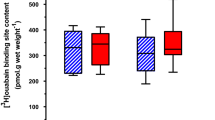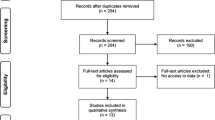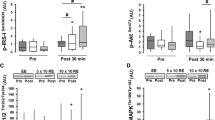Abstract
Contractile function of skeletal muscle relies on the ability of muscle fibers to trigger and propagate action potentials (APs). These electrical signals are created by transmembrane ion transport through ion channels and membrane transporter systems. In this regard, the Cl− ion channel 1 (ClC-1) and the Na+/K−-ATPase (NKA) are central for maintaining ion homeostasis across the sarcolemma during intense contractile activity. Therefore, this randomized controlled trial aimed to investigate the changes in ClC-1 and specific NKA subunit isoform expression in response to six weeks (18 training sessions) of high-load resistance exercise (HLRE) and low-load blood flow restricted resistance exercise (BFRRE), respectively. HLRE was conducted as 4 sets of 12 repetitions of knee extensions performed at 70% of 1 repetition maximum (RM), while BFRRE was conducted as 4 sets of knee extensions at 30% of 1RM performed to volitional fatigue. Furthermore, the potential associations between protein expression and contractile performance were investigated. We show that muscle ClC-1 abundance was not affected by either exercise modality, whereas NKA subunit isoforms \(\alpha\)2 and \(\beta\)1 increased equally by appx. 80–90% with BFRRE (p < 0.05) and 70–80% with HLRE (p < 0.05). No differential impact between exercise modalities was observed. At baseline, ClC-1 protein expression correlated inversely with dynamic knee extensor strength (r=-0.365, p = 0.04), whereas no correlation was observed between NKA subunit content and contractile performance at baseline. However, training-induced changes in NKA \(\alpha\)2 subunit (r = 0.603, p < 0.01) and \(\beta\)1 subunit (r = 0.453, p < 0.05) correlated with exercise-induced changes in maximal voluntary contraction. These results suggest that the initial adaptation to resistance-based exercise does not involve changes in ClC-1 abundance in untrained skeletal muscle, and that increased content of NKA subunits may facilitate increases in maximal force production.






Similar content being viewed by others
References
Altarawneh MM, Petersen AC, Farr T, Garnham A, Broatch JR, Halson S, McKenna MJ (2020) Resistance training upregulates skeletal muscle na(+), K(+)-ATPase content, with elevations in both alpha1 and alpha2, but not beta isoforms. Eur J Appl Physiol 120(8):1777–1785. https://doi.org/10.1007/s00421-020-04408-3
American College of Sports, M (2009) American College of Sports Medicine position stand. Progression models in resistance training for healthy adults. Med Sci Sports Exerc 41(3):687–708. https://doi.org/10.1249/MSS.0b013e3181915670
Atherton PJ, Babraj J, Smith K, Singh J, Rennie MJ, Wackerhage H (2005) Selective activation of AMPK-PGC-1alpha or PKB-TSC2-mTOR signaling can explain specific adaptive responses to endurance or resistance training-like electrical muscle stimulation. FASEB J 19(7):786–788. https://doi.org/10.1096/fj.04-2179fje
Baekgaard Nielsen O, de Paoli FV, Riisager A, Pedersen TH (2017) Chloride channels take Center Stage in Acute Regulation of excitability in skeletal muscle: implications for fatigue. Physiol (Bethesda) 32(6):425–434. https://doi.org/10.1152/physiol.00006.2015
Bangsbo J, Madsen K, Kiens B, Richter EA (1996) Effect of muscle acidity on muscle metabolism and fatigue during intense exercise in man. J Physiol 495(Pt 2):587–596
Bergstrom J (1975) Percutaneous needle biopsy of skeletal muscle in physiological and clinical research. Scand J Clin Lab Invest 35(7):609–616
Broch-Lips M, de Paoli F, Pedersen TH, Overgaard K, Nielsen OB (2011) Effects of 8 wk of voluntary unloaded wheel running on K + tolerance and excitability of soleus muscles in rat. J Appl Physiol (1985) 111(1):212–220. https://doi.org/10.1152/japplphysiol.00687.2010
Buckner SL, Jessee MB, Dankel SJ, Mattocks KT, Mouser JG, Bell ZW, Loenneke JP (2018) Acute skeletal muscle responses to very low-load resistance exercise with and without the application of blood flow restriction in the upper body. Clin Physiol Funct Imaging. https://doi.org/10.1111/cpf.12557
Christiansen D, Eibye KH, Rasmussen V, Voldbye HM, Thomassen M, Nyberg M, Bangsbo J (2019) Cycling with blood flow restriction improves performance and muscle K(+) regulation and alters the effect of anti-oxidant infusion in humans. J Physiol 597(9):2421–2444. https://doi.org/10.1113/JP277657
Christiansen D, Murphy RM, Bangsbo J, Stathis CG, Bishop DJ (2018) Increased FXYD1 and PGC-1alpha mRNA after blood flow-restricted running is related to fibre type-specific AMPK signalling and oxidative stress in human muscle. Acta Physiol (Oxf) 223(2):e13045. https://doi.org/10.1111/apha.13045
Clausen T (2003) Na+-K + pump regulation and skeletal muscle contractility. Physiol Rev 83(4):1269–1324. https://doi.org/10.1152/physrev.00011.2003
Clausen T, Nielsen OB (1994) The Na+,K(+)-pump and muscle contractility. Acta Physiol Scand 152(4):365–373. https://doi.org/10.1111/j.1748-1716.1994.tb09818.x
de Paoli FV, Broch-Lips M, Pedersen TH, Nielsen OB (2013) Relationship between membrane Cl- conductance and contractile endurance in isolated rat muscles. J Physiol 591(2):531–545. https://doi.org/10.1113/jphysiol.2012.243246
de Paoli FV, Ortenblad N, Pedersen TH, Jorgensen R, Nielsen OB (2010) Lactate per se improves the excitability of depolarized rat skeletal muscle by reducing the Cl- conductance. J Physiol 588(Pt 23):4785–4794. https://doi.org/10.1113/jphysiol.2010.196568
Dela F, Holten M, Juel C (2004) Effect of resistance training on na,K pump and Na+/H + exchange protein densities in muscle from control and patients with type 2 diabetes. Pflugers Arch 447(6):928–933. https://doi.org/10.1007/s00424-003-1213-x
Farup J, de Paoli F, Bjerg K, Riis S, Ringgard S, Vissing K (2015) Blood flow restricted and traditional resistance training performed to fatigue produce equal muscle hypertrophy. Scand J Med Sci Sports 25(6):754–763. https://doi.org/10.1111/sms.12396
Fujita S, Abe T, Drummond MJ, Cadenas JG, Dreyer HC, Sato Y, Rasmussen BB (2007) Blood flow restriction during low-intensity resistance exercise increases S6K1 phosphorylation and muscle protein synthesis. J Appl Physiol (1985) 103(3):903–910. https://doi.org/10.1152/japplphysiol.00195.2007
Green H, Dahly A, Shoemaker K, Goreham C, Bombardier E, Ball-Burnett M (1999) Serial effects of high-resistance and prolonged endurance training on Na+-K + pump concentration and enzymatic activities in human vastus lateralis. Acta Physiol Scand 165(2):177–184. https://doi.org/10.1046/j.1365-201x.1999.00484.x
Green HJ, Barr DJ, Fowles JR, Sandiford SD, Ouyang J (2004) Malleability of human skeletal muscle na(+)-K(+)-ATPase pump with short-term training. J Appl Physiol (1985) 97(1):143–148. https://doi.org/10.1152/japplphysiol.00559.2003
Green HJ, Chin ER, Ball-Burnett M, Ranney D (1993) Increases in human skeletal muscle na(+)-K(+)-ATPase concentration with short-term training. Am J Physiol 264(6 Pt 1):C1538–1541. https://doi.org/10.1152/ajpcell.1993.264.6.C1538
Groennebaek T, Jespersen NR, Jakobsgaard JE, Sieljacks P, Wang J, Rindom E, Vissing K (2018) Skeletal muscle mitochondrial protein synthesis and respiration increase with low-load blood Flow Restricted as Well as high-load. Resist Train 9(1796). https://doi.org/10.3389/fphys.2018.01796
Gurtler A, Kunz N, Gomolka M, Hornhardt S, Friedl AA, McDonald K, Posch A (2013) Stain-free technology as a normalization tool in Western blot analysis. Anal Biochem 433(2):105–111. https://doi.org/10.1016/j.ab.2012.10.010
Hansen O, Clausen T (1988) Quantitative determination of Na+-K+-ATPase and other sarcolemmal components in muscle cells. Am J Physiol 254(1):C1–7. https://doi.org/10.1152/ajpcell.1988.254.1.C1
Hart CR, Ryan ZC, Pfaffenbach KT, Dasari S, Parvizi M, Lalia AZ, Lanza IR (2019) Attenuated activation of the unfolded protein response following exercise in skeletal muscle of older adults. Aging 11(18):7587–7604. https://doi.org/10.18632/aging.102273
Hostrup M, Bangsbo J (2017) Limitations in intense exercise performance of athletes - effect of speed endurance training on ion handling and fatigue development. J Physiol 595(9):2897–2913. https://doi.org/10.1113/jp273218
Iaia FM, Thomassen M, Kolding H, Gunnarsson T, Wendell J, Rostgaard T, Bangsbo J (2008) Reduced volume but increased training intensity elevates muscle Na+-K + pump alpha1-subunit and NHE1 expression as well as short-term work capacity in humans. Am J Physiol Regul Integr Comp Physiol 294(3):R966–974. https://doi.org/10.1152/ajpregu.00666.2007
Juel C, Pilegaard H, Nielsen JJ, Bangsbo J (2000) Interstitial K(+) in human skeletal muscle during and after dynamic graded exercise determined by microdialysis. Am J Physiol Regul Integr Comp Physiol 278(2):R400–406. https://doi.org/10.1152/ajpregu.2000.278.2.R400
Klitgaard H, Clausen T (1989) Increased total concentration of Na-K pumps in vastus lateralis muscle of old trained human subjects. J Appl Physiol (1985) 67(6):2491–2494. https://doi.org/10.1152/jappl.1989.67.6.2491
Kutz LC, Mukherji ST, Wang X, Bryant A, Larre I, Heiny JA, Xie Z (2018) Isoform-specific role of Na/K-ATPase alpha1 in skeletal muscle. Am J Physiol Endocrinol Metab 314(6):E620–e629. https://doi.org/10.1152/ajpendo.00275.2017
Lavoie L, Levenson R, Martin-Vasallo P, Klip A (1997) The molar ratios of alpha and beta subunits of the Na+-K+-ATPase differ in distinct subcellular membranes from rat skeletal muscle. Biochemistry 36(25):7726–7732. https://doi.org/10.1021/bi970109s
Leermakers PA, Dybdahl KLT, Husted KS, Riisager A, de Paoli FV, Pinós T, Pedersen TH (2020) Depletion of ATP limits membrane excitability of skeletal muscle by increasing both ClC1-Open probability and membrane conductance. Front Neurol 11. https://doi.org/10.3389/fneur.2020.00541
Medbo JI, Jebens E, Vikne H, Refsnes PE, Gramvik P (2001) Effect of strenuous strength training on the Na-K pump concentration in skeletal muscle of well-trained men. Eur J Appl Physiol 84(1–2):148–154. https://doi.org/10.1007/s004210000311
Nielsen JJ, Mohr M, Klarskov C, Kristensen M, Krustrup P, Juel C, Bangsbo J (2004) Effects of high-intensity intermittent training on potassium kinetics and performance in human skeletal muscle. J Physiol 554(Pt 3):857–870. https://doi.org/10.1113/jphysiol.2003.050658
Nordsborg N, Mohr M, Pedersen LD, Nielsen JJ, Langberg H, Bangsbo J (2003) Muscle interstitial potassium kinetics during intense exhaustive exercise: effect of previous arm exercise. Am J Physiol Regul Integr Comp Physiol 285(1):R143–148. https://doi.org/10.1152/ajpregu.00029.2003
Palade PT, Barchi RL (1977) Characteristics of the chloride conductance in muscle fibers of the rat diaphragm. J Gen Physiol 69(3):325–342
Pedersen TH, de Paoli FV, Flatman JA, Nielsen OB (2009) Regulation of ClC-1 and KATP channels in action potential-firing fast-twitch muscle fibers. J Gen Physiol 134(4):309–322. https://doi.org/10.1085/jgp.200910290
Pedersen TH, Macdonald WA, de Paoli FV, Gurung IS, Nielsen OB (2009) Comparison of regulated passive membrane conductance in action potential-firing fast- and slow-twitch muscle. J Gen Physiol 134(4):323–337. https://doi.org/10.1085/jgp.200910291
Pedersen TH, Nielsen OB, Lamb GD, Stephenson DG (2004) Intracellular acidosis enhances the excitability of working muscle. Science 305(5687):1144–1147. https://doi.org/10.1126/science.1101141
Pedersen TH, Riisager A, de Paoli FV, Chen TY, Nielsen OB (2016) Role of physiological ClC-1 Cl- ion channel regulation for the excitability and function of working skeletal muscle. J Gen Physiol 147(4):291–308. https://doi.org/10.1085/jgp.201611582
Perry BD, Wyckelsma VL, Murphy RM, Steward CH, Anderson M, Levinger I, McKenna MJ (2016) Dissociation between short-term unloading and resistance training effects on skeletal muscle Na+,K+-ATPase, muscle function, and fatigue in humans. J Appl Physiol (1985) 121(5):1074–1086. https://doi.org/10.1152/japplphysiol.00558.2016
Pierno S, Desaphy JF, Liantonio A, De Luca A, Zarrilli A, Mastrofrancesco L, Conte Camerino D (2007) Disuse of rat muscle in vivo reduces protein kinase C activity controlling the sarcolemma chloride conductance. J Physiol 584(Pt 3):983–995. https://doi.org/10.1113/jphysiol.2007.141358
Pirkmajer S, Chibalin AV (2016) Na,K-ATPase regulation in skeletal muscle. Am J Physiology-Endocrinology Metabolism 311(1):E1–E31. https://doi.org/10.1152/ajpendo.00539.2015
Radzyukevich TL, Neumann JC, Rindler TN, Oshiro N, Goldhamer DJ, Lingrel JB, Heiny JA (2013) Tissue-specific role of the Na,K-ATPase alpha2 isozyme in skeletal muscle. J Biol Chem 288(2):1226–1237. https://doi.org/10.1074/jbc.M112.424663
Riisager A, de Paoli FV, Yu WP, Pedersen TH, Chen TY, Nielsen OB (2016) Protein kinase C-dependent regulation of ClC-1 channels in active human muscle and its effect on fast and slow gating. J Physiol 594(12):3391–3406. https://doi.org/10.1113/jp271556
Riisager A, Duehmke R, Nielsen OB, Huang CL, Pedersen TH (2014) Determination of cable parameters in skeletal muscle fibres during repetitive firing of action potentials. J Physiol 592(20):4417–4429. https://doi.org/10.1113/jphysiol.2014.280529
Scott BR, Loenneke JP, Slattery KM, Dascombe BJ (2015) Exercise with blood flow restriction: an updated evidence-based approach for enhanced muscular development. Sports Med 45(3):313–325. https://doi.org/10.1007/s40279-014-0288-1
Sejersted OM, Sjogaard G (2000) Dynamics and consequences of potassium shifts in skeletal muscle and heart during exercise. Physiol Rev 80(4):1411–1481. https://doi.org/10.1152/physrev.2000.80.4.1411
Sieljacks P, Wang J, Groennebaek T, Rindom E, Jakobsgaard JE, Herskind J, Vissing K (2019) Six weeks of low-load blood Flow Restricted and high-load resistance Exercise Training produce similar increases in cumulative myofibrillar protein synthesis and Ribosomal Biogenesis in healthy males. Front Physiol 10:649. https://doi.org/10.3389/fphys.2019.00649
Sjogaard G, Adams RP, Saltin B (1985) Water and ion shifts in skeletal muscle of humans with intense dynamic knee extension. Am J Physiol 248(2 Pt 2):R190–196. https://doi.org/10.1152/ajpregu.1985.248.2.R190
Thomassen M, Hostrup M, Murphy RM, Cromer BA, Skovgaard C, Gunnarsson TP, Bangsbo J (2018) Abundance of ClC-1 chloride channel in human skeletal muscle: fiber type specific differences and effect of training. J Appl Physiol (1985) 125(2):470–478. https://doi.org/10.1152/japplphysiol.01042.2017
Thorstensson A, Karlsson J, Viitasalo JH, Luhtanen P, Komi PV (1976) Effect of strength training on EMG of human skeletal muscle. Acta Physiol Scand 98(2):232–236. https://doi.org/10.1111/j.1748-1716.1976.tb00241.x
Wernbom M, Augustsson J, Raastad T (2008) Ischemic strength training: a low-load alternative to heavy resistance exercise? Scand J Med Sci Sports 18(4):401–416. https://doi.org/10.1111/j.1600-0838.2008.00788.x
West W, Hicks A, McKelvie R, O’Brien J (1996) The relationship between plasma potassium, muscle membrane excitability and force following quadriceps fatigue. Pflugers Arch 432(1):43–49
Wyckelsma VL, McKenna MJ, Serpiello FR, Lamboley CR, Aughey RJ, Stepto NK, Murphy RM (2015) Single-fiber expression and fiber-specific adaptability to short-term intense exercise training of Na+-K+-ATPase α- and β-isoforms in human skeletal muscle. 118:699–706. https://doi.org/10.1152/japplphysiol.00419.2014. 6
Wyckelsma VL, Perry BD, Bangsbo J, McKenna MJ (2019) Inactivity and exercise training differentially regulate abundance of na(+)-K(+)-ATPase in human skeletal muscle. J Appl Physiol (1985) 127(4):905–920. https://doi.org/10.1152/japplphysiol.01076.2018
Acknowledgements
We would like to thank Gitte Kaiser Hartvigsen for technical assistance. We also acknowledge Jon Hagen Herskind and Anders Gravholdt for tremendous efforts in conducting the randomized controlled trial.
Funding
This study was supported by grants from Novo Nordisk Foundation (NNF15OC0016674) and Aarhus University Research Foundation (AUFF-E-2O15-FLS-7-32).
Author information
Authors and Affiliations
Contributions
THP, KV and FdP contributed to the conception and study design. JW wrote the first manuscript draft. JW, ER, TG, JEJ, JF, PS and FdP contributed with data acquisition. All authors interpreted data, critically revised the manuscript, provided intellectual and scientific contributions, and approved the final version of the manuscript submitted for publication.
Corresponding author
Ethics declarations
Conflicts of interests
The authors declare no conflicts of interests, financial or otherwise.
Competing interests
The authors declare no competing interests.
Additional information
Publisher’s Note
Springer Nature remains neutral with regard to jurisdictional claims in published maps and institutional affiliations.
Rights and permissions
Springer Nature or its licensor (e.g. a society or other partner) holds exclusive rights to this article under a publishing agreement with the author(s) or other rightsholder(s); author self-archiving of the accepted manuscript version of this article is solely governed by the terms of such publishing agreement and applicable law.
About this article
Cite this article
Wang, J., Rindom, E., Groennebaek, T. et al. Six weeks of high-load resistance and low-load blood flow restricted training increase Na/K-ATPase sub-units α2 and β1 equally, but does not alter ClC-1 abundance in untrained human skeletal muscle. J Muscle Res Cell Motil 44, 25–36 (2023). https://doi.org/10.1007/s10974-023-09644-6
Received:
Accepted:
Published:
Issue Date:
DOI: https://doi.org/10.1007/s10974-023-09644-6




